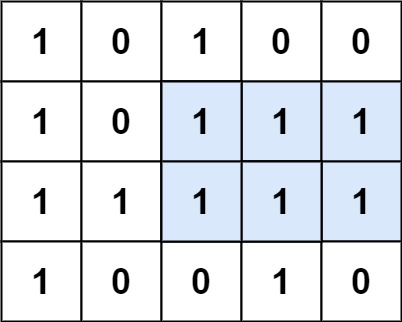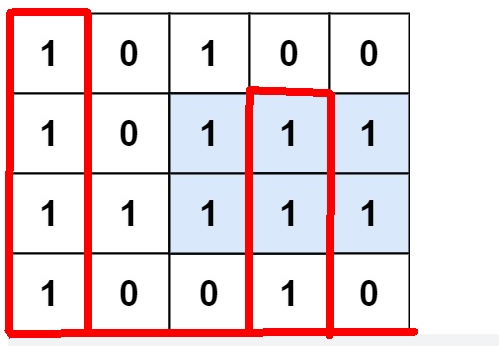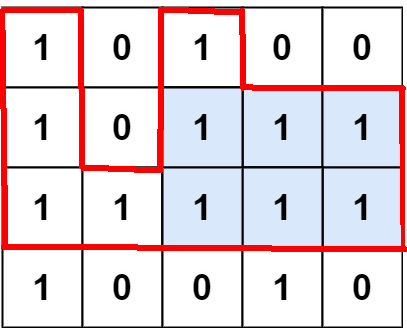最大矩形
Tips
题目
给定一个仅包含 0 和 1, 大小为 rows * cols 的二维二进制矩阵, 找出只包含 1 的最大矩形, 并返回其面积.
提示:
rows == matrix.lengthcols == matrix[0].length1 <= rows, cols <= 200matrix[i][j]为0或1
示例

输入: matrix = [[4, 0, 0, 3, 0], [3, 1, 3, 2, 2], [2, 0, 2, 1, 1], [1, 0, 1, 0, 0]]
输出: 6
解释: 最大矩形如上图所示.
题解
本题的要点是想办法把二维矩阵变成如下方式:
以最后一行 row 为底, 可以得到 heights 为 [4, 0, 0, 3, 0].

以倒数第二行 row 为底, 可以得到 heights 为 [3, 1, 3, 2, 2.

以此类推, 我们得到一组 heights. 这样我们用 84. 柱状图中最大的矩形 的方法, 计算每组 heights 的最大面积, 最终取最大值即可.
- JavaScript
- Rust
/**
* @param {character[][]} matrix
* @return {number}
*/
var maximalRectangle = function (matrix) {
const m = matrix.length
const n = matrix[0].length
const allHeights = []
for (let i = m - 1; i >= 0; i--) {
const heights = []
for (let j = 0; j < n; j++) {
let count = 0
for (let k = i; k >= 0; k--) {
if (matrix[k][j] === '1') {
count++
} else {
break
}
}
heights.push(count)
}
allHeights.push(heights)
}
let max = 0
for (const heights of allHeights) {
max = Math.max(max, largestRectangleArea(heights))
}
return max
}
/**
* @param {number[]} heights
* @return {number}
*/
var largestRectangleArea = function (heights) {
const n = heights.length
const left = new Array(n).fill(-1)
const right = new Array(n).fill(n)
const stack = []
for (let i = 0; i < n; i++) {
while (stack.length > 0 && heights[stack[stack.length - 1]] > heights[i]) {
right[stack.pop()] = i
}
stack.push(i)
}
for (let i = n - 1; i >= 0; i--) {
while (stack.length > 0 && heights[stack[stack.length - 1]] > heights[i]) {
left[stack.pop()] = i
}
stack.push(i)
}
let max = 0
for (let i = 0; i < n; i++) {
const height = heights[i]
const leftIdx = left[i]
const rightIdx = right[i]
max = Math.max(max, (rightIdx - leftIdx - 1) * height)
}
return max
}
use std::cmp;
pub fn maximal_rectangle(matrix: Vec<Vec<char>>) -> i32 {
let m = matrix.len();
let n = matrix[0].len();
let mut all_heights = vec![];
for i in (0..m).rev() {
let mut heights = vec![];
for j in (0..n) {
let mut count = 0;
for k in (0..=i).rev() {
if matrix[k][j] == '1' {
count += 1;
} else {
break;
}
}
heights.push(count);
}
all_heights.push(heights);
}
let mut max = 0;
for heights in all_heights {
max = cmp::max(max, largest_rectangle_area(heights));
}
max
}
fn largest_rectangle_area(heights: Vec<i32>) -> i32 {
let n = heights.len();
let mut left: Vec<isize> = vec![-1; n];
let mut right = vec![n; n];
let mut stack = vec![];
for i in 0..n {
while !stack.is_empty() && heights[stack[stack.len() - 1]] > heights[i] {
right[stack.pop().unwrap()] = i;
}
stack.push(i);
}
for i in (0..n).rev() {
while !stack.is_empty() && heights[stack[stack.len() - 1]] > heights[i] {
left[stack.pop().unwrap()] = i as isize;
}
stack.push(i);
}
let mut max = 0;
for i in 0..n {
let height = heights[i];
let left_idx = left[i];
let right_idx = right[i];
max = cmp::max(max, height * (right_idx as i32 - left_idx as i32 - 1));
}
max
}